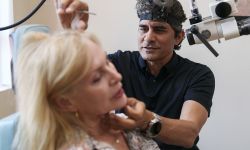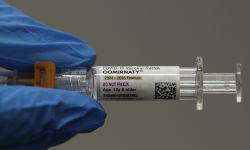Gretchen Whitmer drops mask suggestion, Michigan getting ‘back to normal’

March 28: More boosters, better guesses: 5 things you still should know about COVID
March 18: As pandemic wanes, Michigan confronts toll of isolation on homebound seniors
March 17: Omicron sub-variant BA.2 cases creep up in Michigan; some fear another wave
March 4: Angry Up North: scars linger after Michigan school mask mandates end
March 3: Michigan State University to relax COVID-19 mask mandate
Gov. Gretchen Whitmer’s administration on Wednesday dropped its recommendation that everyone wear masks in many indoor settings, including in schools, citing big drops in new COVID-19 infections.
The state released updated COVID-19 mask guidelines as case counts and COVID-19 hospitalizations continue to plummet, with the state’s hospitals on Wednesday treating fewer than 2,000 COVID-19 patients for the first time since Oct. 8.
In making the change, the Michigan Department of Health and Human Services said the state is in a “recovery” phase and does not anticipate a resurgence of infections.
Related:
- University of Michigan team links ‘rogue’ antibodies to COVID blood clots
- Experts: Politics, as well as science, fuel Whitmer COVID, mask decisions
- One Michigan mom rejoices, another worries as school mask mandates lift
- Detroit superintendent unlikely to push for staff vaccine mandate terminations
- New guidance: Most in Michigan can ditch their masks for now
- Michigan state employees won’t have to mask at work starting Thursday
In a statement, Whitmer called the decision “good news,” noting Michigan had not changed its guidelines on mask policies since last June.
Since then, the state endured a deadly surge spurred first by the delta variant, in which more than 6,000 deaths were linked to COVID-19, and then another surge of the omicron variant began in mid-December, with more than 630,000 infections tied to it.
"While Michigan hasn't had statewide mask policies since last June, this updated guidance will underscore that we are getting back to normal,” Whitmer said in the statement. “Let's keep working together to build on our momentum so we can keep our kids learning in person.”
Last week, public health leaders in the remaining counties with school mask mandates, including Wayne, Oakland, Washtenaw and Ingham, announced plans to rescind school mask mandates, some at the end of this month.
Leaders in states across the country have made similar recommendations as the nation exits the omicron surge.
Critics of the governor have long attacked her for pandemic restrictions, particularly early in the pandemic. But Whitmer and MDHHS avoided imposing statewide mandates as the current school year began, leaving those decisions to local health departments and school districts. But the state’s continued mask recommendation was cited by many local officials as a factor in their decision to implement school mask mandates.
MDHHS defines new “phases”
The new state guidance may not cause sweeping changes in behavior in a state that has become increasingly divided into the masked and unmasked.
Rather, its import is to reframe the pandemic going forward into three simplified phases, compared to the six intervals of a pandemic outlined by the U.S. Centers for Disease Control and Prevention, said Dr. Juan Marquez, medical director of Washtenaw County Health Department.
The three phases allows Michigan residents and policy-makers to understand the extent to which they should employ the tools of COVID control — masking, social-distancing, and other measures — going forward, Marquez said.
The MDHHS said it will base future mask guidance on three factors:
- Response phase: Should local or state public health implement rapid response policies to combat a future surge, the public may be advised to increase masking, testing and social distancing.
- Recovery phase: When a surge has ended and no immediate resurgence is predicted, public health officials will monitor conditions that could lead to future surges.
- Readiness phase: If a surge in cases is expected that carry serious risk of illness and hospitalizations, the state will communicate those risks to the public.
The new guidance “does speak to the different situation we’re in now, but the bigger piece is this shifting of the framework in how we feel about surges and how we manage them,” Marquez said.
MDHHS continues to recommend “all individuals, regardless of vaccination status, continue to practice universal masking in high-risk congregate settings including long-term care facilities, homeless shelters, correctional facilities, jails and health care facilities.”
It also recommends that everyone, regardless of vaccination status, wear a mask during isolation and quarantine periods.
Though MDHHS mask guidelines from last June were only recommended, Whitmer strongly supported local mask mandates amid a surge in new COVID cases last September as the school year began.
Whitmer signed a budget bill in late September that included a Republican provision that counties could lose funding if they imposed mask mandates, but she said she was willing to do so because she considered the provision “unenforceable,” and continued to back county efforts to keep mandates.
“Local health departments should keep their mask policies in place,” Whitmer spokesperson Bobby Leddy said in a statement last September. At the time, cases of COVID-19 were rising quickly, particularly among school-age children.
Impact unclear on remaining mandates
Some of the last remaining county school mask orders were to remain in place until Feb. 28, and it was not immediately clear whether the updated state recommendations Wednesday would shift that date.
Oakland County spokesperson Bill Mullan said the county’s position remains unchanged and the school mask order there remains in place until Feb. 28 to give school administrators time to adjust their policies.
Oakland County’s decision last week aligns with the new state recommendations Wednesday — that masks are recommended in high-risk areas, and that schools and local health departments should consider local case numbers and other factors in determining school mandates, he said.
Likewise, Marquez said it’s “reasonable” that Washtenaw County’s requirement remains in place until Feb. 28.
Woodhaven-Brownstown School District Superintendent Mark Greathead told Bridge Michigan the Wednesday announcement doesn’t necessarily change anything in his district.
“We’ll continue to work with our local health department,” he said.
His district of about 5,500 students is still requiring masks but Wayne County has said it will remove its mask requirement by the end of the month. He said the state’s announcement Wednesday just highlights what school districts already knew: they need to rely on medical experts.
“From a statewide perspective, I think it's great news and that means we're heading in the right direction,” Greathead said.
Since the pandemic began in March 2020, there have been more than 2 million confirmed or suspected coronavirus infections in Michigan and more than 31,200 COVID-19 deaths.
Unlike leaders in some states, however, Whitmer resisted calls for a school mask mandate as the school year began last September, saying local public health and school leaders were better able to decide.
Instead, some counties and school districts enacted their own mandates with roughly 60 percent of students covered by mandates at one point.
— Staff writer Isabel Lohman contributed.
See what new members are saying about why they donated to Bridge Michigan:
- “In order for this information to be accurate and unbiased it must be underwritten by its readers, not by special interests.” - Larry S.
- “Not many other media sources report on the topics Bridge does.” - Susan B.
- “Your journalism is outstanding and rare these days.” - Mark S.
If you want to ensure the future of nonpartisan, nonprofit Michigan journalism, please become a member today. You, too, will be asked why you donated and maybe we'll feature your quote next time!








